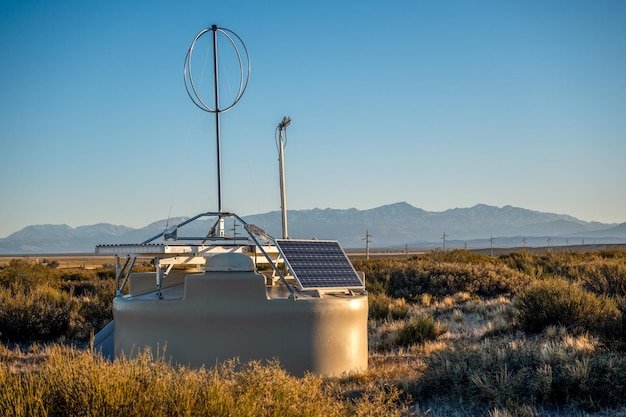Impact of the 2025 Infrastructure Bill on Renewable Energy Investments in the US

The 2025 Infrastructure Bill significantly impacts renewable energy investments in the US by allocating substantial funding for renewable energy projects, modernizing the grid, and incentivizing clean energy technologies, fostering growth and innovation in the sector.
The **Impact of the 2025 Infrastructure Bill on Renewable Energy Investments in the US** is poised to be transformative. This legislation earmarks significant resources for bolstering renewable energy infrastructure, fostering innovation, and facilitating the transition to a cleaner energy economy.
Understanding the 2025 Infrastructure Bill and Its Objectives
The 2025 Infrastructure Bill represents a monumental investment in America’s future. Beyond repairing roads and bridges, a core objective is to modernize the nation’s energy infrastructure and accelerate the adoption of renewable energy sources. This section delves into the specific goals and provisions of the bill relevant to renewable energy.
Key Provisions for Renewable Energy
Several key provisions within the Infrastructure Bill are specifically designed to boost renewable energy investments. These include funding for grid modernization, tax incentives for clean energy projects, and grants for research and development.
Goals of the Infrastructure Bill
The overarching goals include reducing carbon emissions, creating clean energy jobs, and ensuring a reliable and resilient energy supply for all Americans. By incentivizing renewable energy development, the bill aims to address climate change and stimulate economic growth.
- Modernizing the electric grid to accommodate more renewable energy sources.
- Providing tax credits and incentives for renewable energy projects.
- Supporting research and development of new clean energy technologies.
- Creating jobs in the renewable energy sector.
The bill aims to reduce reliance on fossil fuels, promoting energy independence and environmental sustainability. These strategic investments in renewable infrastructure are intended to yield long-term economic and environmental benefits.

Direct Funding and Grants for Renewable Energy Projects
A significant portion of the Infrastructure Bill’s budget is allocated to direct funding and grants for renewable energy projects. These funds are crucial for supporting the development, deployment, and expansion of renewable energy infrastructure across the country. This section examines how these financial resources are distributed and their intended impact.
Allocation of Funds
The funding is strategically allocated to various renewable energy sectors, including solar, wind, hydropower, and geothermal energy. Each sector receives targeted support based on its potential for growth and contribution to the nation’s renewable energy goals.
Eligibility Criteria for Grants
Specific criteria are established to ensure that the grants are awarded to projects that align with the bill’s objectives. These criteria often include factors such as project viability, environmental impact, job creation potential, and community benefits.
- Projects must demonstrate a clear path to commercial viability.
- Environmental impact assessments are required to minimize negative effects.
- Projects must create local jobs and stimulate economic activity.
- Community engagement and benefits are prioritized.
The direct funding and grants provide a crucial financial boost to renewable energy developers, enabling them to undertake ambitious projects that would otherwise be difficult to finance. This financial support accelerates the transition to a cleaner energy future.
Incentives and Tax Credits for Renewable Energy Investments
In addition to direct funding, the Infrastructure Bill includes a variety of incentives and tax credits designed to attract private investment in renewable energy. These incentives play a vital role in making renewable energy projects more economically competitive. This section examines the specific incentives and their potential to stimulate investment.
Types of Tax Credits
The bill offers different types of tax credits for renewable energy investments, including the Investment Tax Credit (ITC) and the Production Tax Credit (PTC). These credits reduce the tax burden on renewable energy projects, improving their financial feasibility.
Impact on Private Investment
The tax credits and incentives significantly enhance the attractiveness of renewable energy projects to investors. By reducing the financial risks and increasing the potential returns, these incentives encourage private sector participation in the renewable energy sector.
- The ITC provides a percentage-based tax credit based on the cost of the investment.
- The PTC offers a tax credit for each kilowatt-hour of electricity generated from renewable sources.
- These incentives help level the playing field and make renewable energy competitive with fossil fuels.
- Increased private investment accelerates the deployment of renewable energy technologies.
These incentives are crucial for mobilizing private capital and driving innovation in the renewable energy industry. The combination of direct funding and tax incentives creates a supportive environment for renewable energy growth.

Modernizing the Electric Grid for Renewable Energy Integration
A modern and resilient electric grid is essential for integrating renewable energy sources effectively. The Infrastructure Bill recognizes this need and allocates substantial funding for grid modernization projects. This section focuses on the grid modernization provisions and their impact on renewable energy integration.
Smart Grid Technologies
The bill promotes the deployment of smart grid technologies, which enable better monitoring, control, and optimization of the electricity grid. These technologies enhance the grid’s ability to handle the variability of renewable energy sources.
Transmission Infrastructure Improvements
Significant investments are directed towards upgrading and expanding transmission infrastructure. These improvements are essential for transporting renewable energy from remote generation sites to urban centers. The goal is to ensure the grid can handle the increased renewable energy load.
- Smart grid technologies improve grid efficiency and reliability.
- Upgrading transmission lines reduces bottlenecks and ensures smooth energy flow.
- Energy storage solutions are crucial for managing the intermittent nature of renewable energy.
- Modernizing the grid enhances overall energy security and resilience.
These upgrades facilitate the seamless integration of renewable energy sources into the grid, maximizing their contribution to the nation’s energy supply. A modern grid is vital for achieving the full potential of renewable energy.
Job Creation and Economic Growth in the Renewable Energy Sector
The Infrastructure Bill is expected to create numerous jobs and stimulate economic growth in the renewable energy sector. These economic benefits are a key driver behind the bill’s support for renewable energy. This section examines the potential for job creation and economic expansion in the renewable energy industry.
New Job Opportunities
The expansion of renewable energy projects is expected to generate thousands of new jobs in manufacturing, construction, installation, and maintenance. These jobs offer opportunities for workers transitioning from traditional energy sectors.
Economic Benefits for Communities
Renewable energy projects can bring significant economic benefits to local communities, including increased property tax revenues, new business opportunities, and improved quality of life. These benefits contribute to overall economic prosperity.
- Renewable energy projects create well-paying jobs in various fields.
- Local communities benefit from increased economic activity and tax revenues.
- The renewable energy sector attracts investment and fosters innovation.
- A cleaner environment enhances public health and reduces healthcare costs.
By promoting sustainable economic development, the Infrastructure Bill aims to create a more prosperous and resilient economy. The investments in renewable energy are expected to yield long-term economic benefits for communities across the country.
Challenges and Opportunities for Renewable Energy Investments
Despite the significant opportunities, the renewable energy sector faces various challenges. Addressing these challenges is crucial for maximizing the impact of the Infrastructure Bill. This section identifies key challenges and explores potential solutions to overcome them.
Regulatory Hurdles
Complex and lengthy permitting processes can delay or hinder renewable energy projects. Streamlining these processes is essential for accelerating project development. Regulatory clarity and simplification are needed to reduce uncertainty and attract investment.
Financing Challenges
Securing financing for large-scale renewable energy projects can be difficult, particularly for emerging technologies. Innovative financing mechanisms and public-private partnerships can help overcome these challenges. Access to capital is crucial for driving innovation and deployment.
- Streamlining permitting processes reduces project delays and costs.
- Providing access to affordable financing attracts private investment.
- Addressing supply chain constraints ensures the availability of critical materials.
- Investing in workforce development creates a skilled labor pool.
By addressing these challenges and capitalizing on the opportunities, the Infrastructure Bill can unlock the full potential of renewable energy. Overcoming these hurdles is essential for achieving a sustainable energy future.
| Key Point | Brief Description |
|---|---|
| 💰 Funding Boost | Bill allocates significant funds for renewable projects. |
| ⚡ Grid Modernization | Upgrades enhance renewable energy integration. |
| 🌱 Tax Incentives | Attract private investment in renewable projects. |
| 💼 Job Creation | Bill stimulates job growth in clean energy sector. |
Frequently Asked Questions
▼
The bill supports various renewable sources, including solar, wind, hydropower, geothermal, and biomass. Each receives targeted funding based on potential contribution and scalability.
▼
The bill invests in research and development of energy storage technologies, supporting projects that enhance grid stability and manage the intermittent nature of renewables.
▼
Key incentives include the Investment Tax Credit (ITC) and Production Tax Credit (PTC), which reduce tax liabilities for investments and electricity production from renewables.
▼
The bill aims to streamline permitting processes and reduce regulatory complexities, facilitating faster project development and deployment of renewable energy technologies.
▼
The bill is projected to create thousands of jobs in manufacturing, construction, installation, and maintenance of renewable energy projects, boosting economic growth.
Conclusion
The 2025 Infrastructure Bill represents a pivotal opportunity to accelerate the transition to a sustainable energy future in the United States. By providing substantial funding, incentives, and support for grid modernization, the bill is poised to transform the renewable energy landscape, driving innovation, creating jobs, and reducing carbon emissions.





